Wrocław-Lower Silesian,Poland 作者: 来源: 发布时间:2021-03-05
Ⅰ. Population and Area
Country Poland
Lower Silesian
Population (31 December 2019)
• City 642,869 Increase (4th)
• Metro 1,164,600
Area
• City 292.92 km2 (113.10 sq mi)
Ⅱ.Natural Geography (environment and resources)
- It lies on the banks of the River Oder in the Silesian Lowlands of Central Europe, roughly 350 kilometres (220 mi) from the Baltic Sea to the north and 40 kilometres (25 mi) from the Sudeten Mountains to the south. The population of Wrocław in 2019 was 642,869, making it the fourth-largest city in Poland and the main city of the Wrocław agglomeration.
- Wroclaw is located in the center of Silesian Lowland 51 07 'north latitude 17 02' eastern length. Wroclaw is one of the warmest cities in Poland. Lying in the Lower-Silesian region, one of the warmest in Poland, the mean annual temperature is 9.8 °C. The coldest month is January (average temperature -0.5°C), and the warmest is July (average temperature 19.9°C). The longest season is summer, which lasts 114 days. The highest temperature in Wroclaw was recorded on 31 July 1994 (+37.9°C), and the lowest was recorded on 8 January 1985 (-30.0°C). Annual rainfall in Wroclaw is 620 mm per year. Wroclaw's major industries were traditionally the manufacture of railroad cars and electronics. In recent years the City Council has run an active policy to attract foreign investors from the high-tech sector. This resulted among others in the location of LG Electronics production cluster in Kobierzyce near Wroclaw. After 1989, Wroclaw became a significant financial centre and houses the headquarters of several nationwide financial institutions. As of the end of 2008, Wroclaw enjoyed a very low unemployment level of just 3.2% compared with the national level of 8.7%. In 2008, per capita gross domestic product in Wroclaw came to 27755$ (in Poland 17625$).
Transport
Wrocław is a major road hub. The city is skirted on the south by the A4 highway, which allows for a quick connection with Upper Silesia, Kraków, and further east to Ukraine, and Dresden, Leipzig, Berlin to the west. The A8 highway (Wrocław ring road) around the west and north of the city connects the A4 highway with the S5 express road that leads to Poznań, Bydgoszcz and S8 express road that leads to Oleśnica, Łódź, Warsaw, Białystok and National Road 5 and National Road 8 to the Czech Republic. Under construction is the eastern part of the Wrocław ring road.
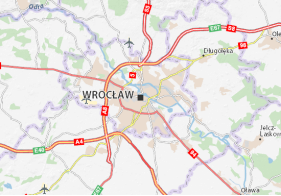
The city is served by Copernicus Airport Wrocław (airport code WRO) which handles flights from LOT Polish Airlines, Buzz, Ryanair, Wizz Air, Lufthansa, Eurowings, Air France, KLM, Scandinavian Airlines, Swiss International Air Lines, and Norwegian Air Shuttle.
The main rail station is Wrocław Główny, which is the largest railway station in Poland (21,2 million passengers a year).[83] The station is supported by PKP Intercity, Polregio, Koleje Dolnośląskie and Leo Express.
Wrocław has direct rail connections with:
Warsaw – 3,5 h,
Kraków – 3 h,
Gdańsk – 5 h,
Poznań – 2 h,
Szczecin – 6 h,
Berlin – 4 h,
Prague – 4,5 h,
Vienna – 7 h,
Bratislava – 6 h
Budapest – 9 h
Adjacent to the railway station, is a central bus station located in the basement of the shopping mall of "Wroclavia", with services offered by PKS, Flixbus, Sindbad, and others.
Public transport in Wrocław includes bus lines and 23 tram lines operated by Miejskie Przedsiębiorstwo Komunikacyjne (MPK, the Municipal Transport Company).[84] Rides are paid for, tickets can be bought above kiosks and vending machines, which are located at bus stops and in the vehicles. The tickets are available for purchase in the electronic form via payment card or mobile (mPay, SkyCash, Mobill). Tickets are one-ride or temporary (0.5h, 1h, 1.5h, 24h, 48h, 72h, 168h).
Over a dozen traditional taxicab firms and Uber, iTaxi, Bolt, Free Now operate in the city. In the city there is an e-systems the firms of Lime, Bird and Hive Free Now motorized scooters rental using a mobile application.
Ⅲ.Economy
Wrocław is the second wealthiest city in Poland after Warsaw. The city is also home to the largest number of leasing and debt collection companies in the country, including the largest European Leasing Fund as well as numerous banks. Due to the proximity of the borders with Germany and the Czech Republic, Wrocław and the region of Lower Silesia is a large import and export partner with these countries.
Since the beginning of the 21st century, the city has had a developing high-tech sector. Many high-tech companies are located in the Wrocław Technology Park, such as Baluff, CIT Engineering, Caisson Elektronik, ContiTech, Ericsson, Innovative Software Technologies, IBM, IT-MED, IT Sector, LiveChat Software, Mitsubishi Electric, Maas, PGS Software, Technology Transfer Agency Techtra and Vratis. In Biskupice Podgórne (Community Kobierzyce) there are factories of LG (LG Display, LG Electronics, LG Chem, LG Innotek), Dong Seo Display, Dong Yang Electronics, Toshiba, and many other companies, mainly from the electronics and home appliances sectors, while the Nowa Wieś Wrocławska factory and distribution center of Nestlé Purina and factories a few other enterprises.
The city is the seat of Wrocław Research Centre EIT+, which contains, inter alia, geological research laboratories to the unconventional and Lower Silesian Cluster of Nanotechnology. The logistics centers DHL, FedEx and UPS are based in Wrocław. Furthermore, it is a major center for the pharmaceutical industry (U.S. Pharmacia, Hasco-Lek, Galena, Avec Pharma, 3M, Labor, S-Lab, Herbapol, and Cezal).
Wrocław is home to Poland's largest shopping mall – Bielany Avenue (pl. Aleja Bielany) and Bielany Trade Center, located in Bielany Wrocławskie where stores such as Auchan, Decathlon, Leroy Merlin, Makro, Tesco, IKEA, Jula, OBI, Castorama, Black Red White, Poco, E. Wedel, Cargill, Prologis and Panattoni can be found.
In February 2013, Qatar Airways launched its Wrocław European Customer Service.
The Lower Silesia Province, together with Wrocław, was ranked sixth in the Best-performing cities Europe 2017 ranking. The ranking published by an American think tank Milken Institute identified 20 European regional governments with the fastest-growing economies in 2017. The criteria for the assessment were: salary increase, number of new jobs, concentration of industrial production and highly-specialised services sector, among others.
The strong position of Wrocław and the Lower Silesia Province is confirmed by market data. Over the past two and a half years, this Polish region received approx. PLN 2.5 billion of investment, and the GDP increased by 60% in the last 10 years. At the moment, the value of GDP per capita is higher than the national average and continues to increase. Moreover, there are several, e.g. Asian and German, investments being implemented here, especially in the sectors of production and logistics. As an example, Mercedes’ plans to expand in Jawor, as well as those of Toyota, can be mentioned.
Unemployment 2.9%*
Wrocław population 637 000*
Number of students 124 440*
Agglomeration population 1 200 000*
WROCŁAW, June 2020
Population (as at 31 XII 2019) 642.9 thous. ↑
Registered unemployed persons 8.8 thous. ↑
Unemployment rate 2.2% ↑
Average paid employment in enterprise sector 178.2 thous. ↓
Average monthly gross wages and salaries in enterprise sector 5724.43 PLN ↑
Dwellings completed 802 ↑
Entities of the national economy 124.8 thous. ↓
Statistical Office in Wroclaw https://wroclaw.stat.gov.pl/en/
Ⅳ.Industrial Characteristics
Wrocław's industry manufactures buses, railroad cars, home appliances, chemicals, and electronics. The city houses factories and development centers of many foreign and domestic corporations, such as WAGO Kontakttechnik, Siemens, Bosch, Whirlpool Corporation, Nokia Networks, Volvo, HP, IBM, Google, Opera Software, Bombardier Transportation, WABCO and others. Wrocław is also the location of offices for large Polish companies including Getin Holding, AmRest, Polmos, and MCI Management SA. Additionally, Kaufland Poland has its main headquarters in the city。
Major corporations
· 3M
· Akwawit–Polmos S.A. – plant "Wratislavia vodka"
· Bombardier Transportation Polska
· The Bank of New York Mellon
· Crédit Agricole Poland
· Credit Suisse
· Deichmann
· DeLaval Operations Poland
· DHL
· Dolby Labs
· Ernst & Young
· Qatar Airways
· Gigaset Communications
Key Project
1. International giant announces investment plans in Wroclaw
German company Schaeffler, an international supplier of parts for the automotive industry and sector, is opening the Business and IT Service Centre for Europe.
International giant announces investment plans in Wroclaw | www.wroclaw.pl
https://www.wroclaw.pl/en/international-giant-announces-investment-plans-in-wroclaw
2. A new production line for EPP expanded polypropylene car parts has been launched at the Knauf Industries Wrocław production plant. This is another forward-looking investment that fits into the dynamic development of the automotive industry in Lower Silesia.
Knauf Industries Wrocław - production of car parts made of EPP https://knaufautomotive.com/epp-in-wroclaw/
Ⅴ. Landmarks and places of interest
Wrocław is a major attraction for both local and international tourists. Major landmarks include the Multimedia Fountain, Szczytnicki Park with its Japanese Garden, miniature park and dinosaur park, Botanical Garden in Wrocław [pl], founded in 1811, Poland's largest railway model Kolejkowo, Hydropolis Centre for Ecological Education, University of Wrocław with Mathematical Tower, Church of the Name of Jesus [pl], Wrocław water tower, the Royal Palace, ropes course on the Opatowicka Island, White Stork Synagogue, Old Jewish Cemetery, Cemetery for Italian Soldiers.
Wrocław Zoo, home of the Africarium – the only space devoted solely to exhibiting the fauna of Africa with an oceanarium. It is the oldest zoological garden in Poland established in 1865. It is also the third-largest zoo in the world in terms of the number of animal species on display.
Small passenger vessels on the Oder offer river tours, as do historic trams or the converted open-topped historic buses Jelcz 043.
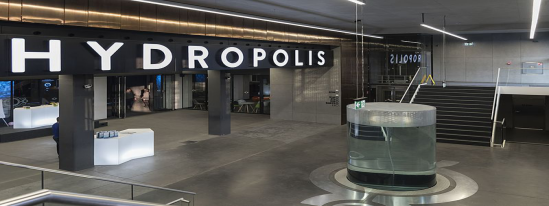
Hydropolis, water multimedia museum
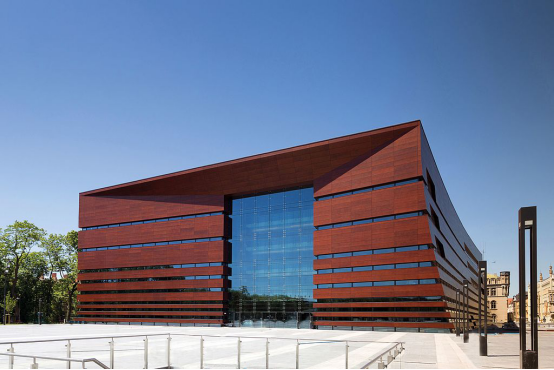
National Forum of Music
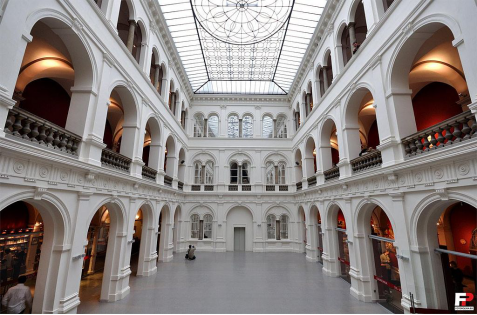
National Museum, Wrocław
The Centennial Hall (Hala Stulecia, German: Jahrhunderthalle), designed by Max Berg in 1911–1913, is a World Heritage Site listed by UNESCO in 2006.
Kobierzyce is the nearby village where Rudolf Steiner presented the first organic agriculture course in 1924. It was, at the time, called Koberwitz.
A frequent destination for tourists visiting Wrocław is the Sudety Mountains, especially the nearby Mount Ślęża.
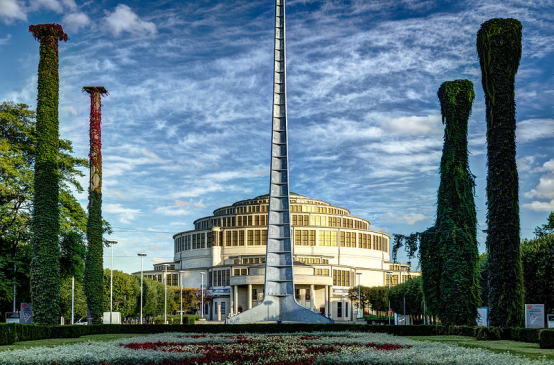
Centennial Hall, UNESCO World Heritage Site
Ⅵ.History and Culture
Wrocław is the historical capital of Silesia and Lower Silesia. Today, it is the capital of the Lower Silesian Voivodeship. The history of the city dates back over a thousand years; at various times, it has been part of the Kingdom of Poland, the Kingdom of Bohemia, the Kingdom of Hungary, the Habsburg Monarchy of Austria, the Kingdom of Prussia and Germany. Wrocław became part of Poland again in 1945 as part of the so-called Recovered Territories as a result of the border changes after the Second World War. This included the flight and expulsion of the pre-war population of the city.
Wrocław is a university city with a student population of over 130,000, making it arguably one of the most youth-oriented cities in the country. Since the beginning of the 20th century, the University of Wrocław, previously Breslau University, has produced 9 Nobel Prize laureates and is renowned for its high quality of teaching.
Wrocław is classified as a Gamma- global city by GaWC. It was placed among the top 100 cities in the world for the Mercer Quality of Living Survey and in the top 100 of the smartest cities in the world in the IESE Cities in Motion Index 2017 and 2019 report. Wrocław also possesses numerous historical landmarks, including the Main Market Square, Cathedral Island and the Centennial Hall, which is listed as a UNESCO World Heritage Site.
In 1989, 1995 and 2019 Wrocław hosted the European Youth Meetings of the Taizé Community and hosted the Eucharistic Congress in 1997 and the 2012 European Football Championship. In 2016, the city was a European Capital of Culture and the World Book Capital. Also in that year, Wrocław hosted the Theatre Olympics, World Bridge Games and the European Film Awards. In 2017, the city was host to the IFLA Annual Conference and the World Games. In 2019, it was named a UNESCO City of Literature.
Ⅶ.Other Information
The city is well known for its large number of nightclubs and pubs. Many are in or near the Market Square, and in the Niepolda passage, the railway wharf on the Bogusławskiego Street. The basement of the old City Hall houses one of the oldest restaurants in Europe—Piwnica Świdnicka (operating since around 1275[109]), while the basement of the new City Hall contains the brewpub Spiż. There are many other craft breweries in Wrocław: three brewpubs – Browar Stu Mostów, Browar Staromiejski Złoty Pies, Browar Rodzinny Prost; two microbrewery – Profesja and Warsztat Piwowarski; and seven contract breweries – Doctor Brew, Genius Loci, Solipiwko, Pol A Czech, Baba Jaga, wBrew, Wielka Wyspa. Every year ,on the second weekend of June the Festival of Good Beer takes place here. It is the biggest beer festival in Poland.
Every year in November and December the Christmas market is held at the Market Square.
Ⅷ.Contact Information
Mayor Jacek Sutryk (.N)
Facebook: Prezydent Wrocławia Jacek Sutryk@sutrykjacek
Email: kancelaria.prezydenta@um.wroc.pl
Twitter: www.twitter.com/SutrykJacek
Wrocław-Official Website | www.wroclaw.pl https://www.wroclaw.pl/en/
50-141 Wrocław, pl. Nowy Targ 1-8
tel. +48 71 777 77 77
faks +48 71 777 86 55
E-mail: kum@um.wroc.pl
